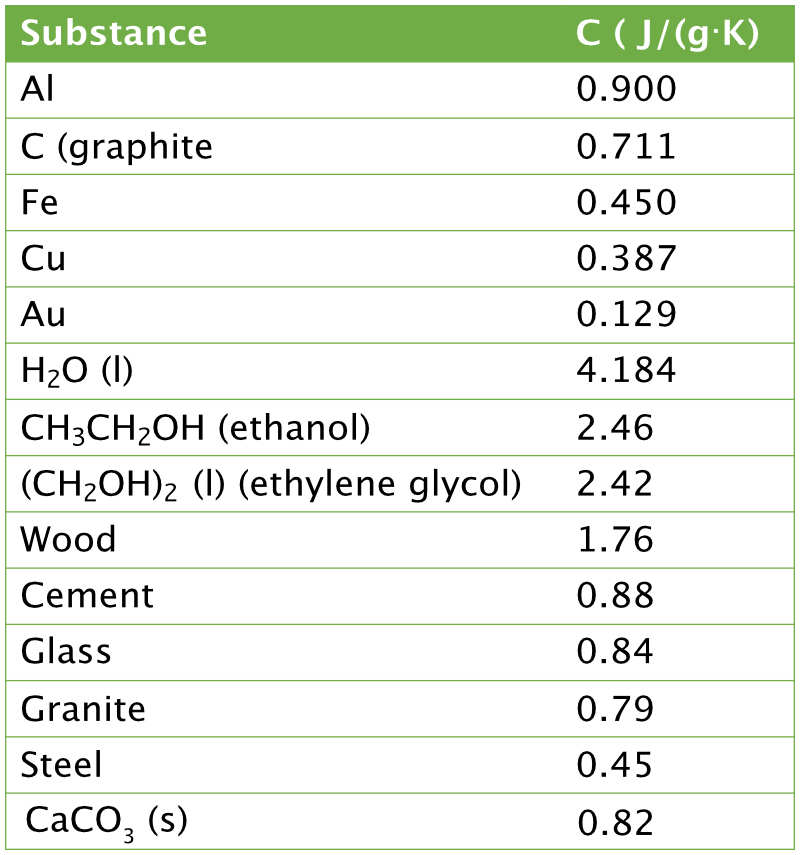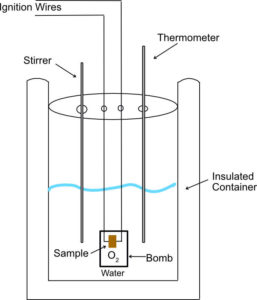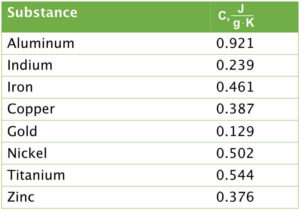Calorimetry is a process that allows us to measure the heat flow of a physical or a chemical change using a calorimeter. The two types of calorimetry that will be discussed are constant pressure calorimetry and constant volume calorimetry.
We know that \(\displaystyle q\;\propto\;T,\;therefore,\;q\;=\;c\;\times\;T\)
where c is a constant. The heat capacity is the quantity of heat, q, required to change the temperature of a substance by 1 K (or 1°C). Recall, Celcius and Kelvin units are equal in size. All objects have a heat capacity. The specific heat capacity, C, is the quantity of heat that is required to change the temperature of 1 gram of a substance or an object by 1 K (or 1°C).
where mass is in grams and ΔT is the final temperature minus the initial temperature.
The units of the specific heat capacity are in J/(g⋅K) or J/(g⋅°C).
Rearranging the above equation,
To determine the heat evolved or absorbed, we need to know the mass of the substance, the specific heat capacity, and the temperature change. In some texts, molar heat capacity is used. Molar heat capacity, Cm is the amount of heat required to change the temperature of one mole of a substance by 1 K (or 1°C).
You can use either specific heat capacity or molar heat capacity when working on problems, but please make sure your units are correct. For example, the molar heat capacity of water can be found by:
In the table below, are specific heat capacities for some common substances. Notice, that water has the highest specific heat capacity. It will take more heat to raise the temperature of 1 gram of water than it would take to raise the temperature of 1 g of iron or 1 g of steel.
If we have 82.5 g of Fe, how much heat would be required to heat the iron from 22.0°C to 185.0°C? The first thing is to find the specific heat capacity for iron and it is 0.450 J/(g⋅K). The temperature difference, ΔT = 185.0°C – 22.0°C = 163°C. This is the same as 176 K as the Kelvin and the Celcius units are the same size.
The value of q is positive, and it would take 6.53 x 103 J to heat the 82.5 g of iron.
Constant Pressure Calorimetry
How do we measure the heat of a physical process or a chemical reaction? We use a calorimeter which will measure the heat absorbed or released by a chemical or a physical process. The first type of calorimeter is a constant pressure calorimeter. The process takes place at a constant pressure and is used to find the heat that is evolved or absorbed of an aqueous reaction, the heat when a salt is dissolved, or the heat capacity of an unknown object. In constant pressure calorimetry we measure qp.
A constant pressure calorimeter can be as simple as a styrofoam coffee cup, a thermometer, and a stirrer. This is the setup that most general chemistry labs use. The styrofoam coffee cup is an insulated vessel, which means heat will not be transferred to or absorbed by the container. This allows the initial temperature of the water and the final temperature of the water to be taken in order to calculate qp at constant atmospheric pressure.
In the figure above, the mass of the solid is first recorded. The solid is heated to some known temperature and then added to a known mass of water with a known temperature. The water is the surroundings, and the solid is the system. The hot solid will transfer heat to the water, and as long as no heat escapes,
Recall, q = mass x C x ΔT, so we can write the expressions for both -q and q as:
Let’s say we heat 24.20 g of an unknown metal to 125.00°C. The metal is added to 40.00 g of water in a coffee cup calorimeter. The water temperature changes from 23.25°C to 29.26°C. The specific heat capacity of H2 is 4.184 J/(g⋅K). What is the specific heat capacity of the unknown metal?
First we define our system and surroundings. The metal, the system, will transfer heat to the water, the surroundings.
We need to solve the following equation for Cmetal
Solving for Cmetal
\(\displaystyle C_{metal}\;=\;-\frac{mass_{H_20}\times\;C_{H_2O}\times\;ΔT_{H_2O}}{mass_{metal}\;\times\;ΔT_{metal}}\)
Find ΔT for both the metal and the water. The initial temperature of the water is 23.25°C and the final temperature of the water is 29.26°C, and ΔT = 29.26°C – 23.25°C = 6.01°C. This is equal to 6.01 K, because the Celcius and Kelvin units are the same size. The temperature change for the metal is, ΔT = 29.26°C – 125.00°C = -95.74°C. This is the same as a temperature difference of -95.74 K. The mass of the metal is 24.20 g and the mass of water is 40.00 g.
Next, put the values into the equation to calculate the specific heat capacity of the unknown metal.
The specific heat capacity of our unknown metal is 0.434 J/(g⋅K). This, combined with other analytical techniques would allow us to identify the metal.
Constant pressure calorimetry is used to determine the heat evolved or absorbed when a salt is dissolved in water. It is also used to determine the enthalpy change, ΔHrxn for a chemical reaction, in which the chemical reaction is the system and the solution is the surroundings (See Exercise 5).
Constant Volume Calorimetry
Constant volume calorimetry measures q at constant volume, qv. Constant volume calorimetry is also called bomb calorimetry. The bomb calorimeter is used to measure heats of combustion for foods, fuels, etc. The pressure is not constant, but the volume is constant meaning ΔV = 0, therefore, PΔV = 0 and ΔE = qv. We need to either know or determine the heat capacity of the calorimeter. The bomb calorimeter is consists of the sample, an ignition unit, oxygen, water, a stainless steel bomb, and an outer insulated vessel or dewar. The O2 and the sample are the system, and the rest of the calorimeter, the water and bomb, are the surroundings.
Suppose we have a 1.000 g peanut that is burned in oxygen in a bomb calorimeter. The temperature of 1000.0 g of H2O in the calorimeter rises from 23.00°C to 27.72°C. The heat capacity of the bomb is 845 J/K and the specific heat capacity of liquid water is 4.184 J/(g⋅K). Calculate the number of food calories (Cal) per gram of peanuts.
The energy evolved as heat in the combustion reaction plus the energy as heat absorbed by the water plus the energy a heat absorbed by the bomb is equal to 0.
We want to calculate the heat released when the peanut is burned in the calorimeter, qrxn.
There is 23735.88 J of heat released when 1 g of peanuts is burned. We need to convert this to food calories (Cal).
1.00 g of peanuts would contain:
A gram of peanuts is 5.7 Cal. A 1/4 cup serving of peanuts (about 36.5 g) is 208 Calories.
Please watch the following videos before attempting exercises
Exercises
Exercise 1. Calculate q, if 55.26 g of water at 85.0 °C is cooled to 22.53°C? What is the sign of q? Cwater = 4.184 J/(g⋅K)
Check Answer/Solution to Exercise 1
Exercise 2. An unknown metal has a mass of 15.65 g. The metal was heated to 190.5°C and added to 65.00 g of H2O with a temperature of 22.5°C. Once thermal equilibrium was established, the temperature of the H2O was 27.6°C. CH2O = 4.184 J/(g⋅K). Which of the metals in the table below could be the unknown metal?
Check Answer/Solution to Exercise 2
Exercise 3. Consider the reaction, at constant pressure, of 150.00 mL of 0.350 M HCl and 150.00 mL of 0.350 M KOH. The temperature of the solutions before mixing was 23.10°C. After the reaction occurred, the temperature of the solution was 25.78°C. What is the enthalpy change per mole (kJ/mol) of the neutralized acid? Is the reaction endothermic or exothermic? Assume solution densities to be 1.00 g/mL and the specific heat capacities are 4.184 J/(g⋅K).
Check Answer/Solution to Exercise 3
Exercise 4. An instant hot pack works based on an exothermic dissolution of a salt.
CaCl2 (s) + H2O (l) → Ca2+ (aq) + 2 Cl– (aq) + H2O (l) ΔH = -82.8 kJ
What is the final temperature of the squeezed hot pack that contains 12.5 g of CaCl2 that is dissolved in 125.0 mL of water? Assume the solution has a specific heat of 4.184 J/(g⋅K). The initial temperature was 22.3°C.
Check Answer/Solution to Exercise 4
Exercise 5. A 1.798 g sample of phenol (C6H5OH) was burned in a bomb calorimeter. The heat capacity of the calorimeter was 11.76 kJ/°C. The temperature increased from 21.47 °C to 26.46°C. What is the heat of combustion for one mole of phenol in kJ/mol?
Check Answer/Solution to Exercise 5
Back to Thermochemistry
Back to General Chemistry 1 Study Guides
Back to Home Page




